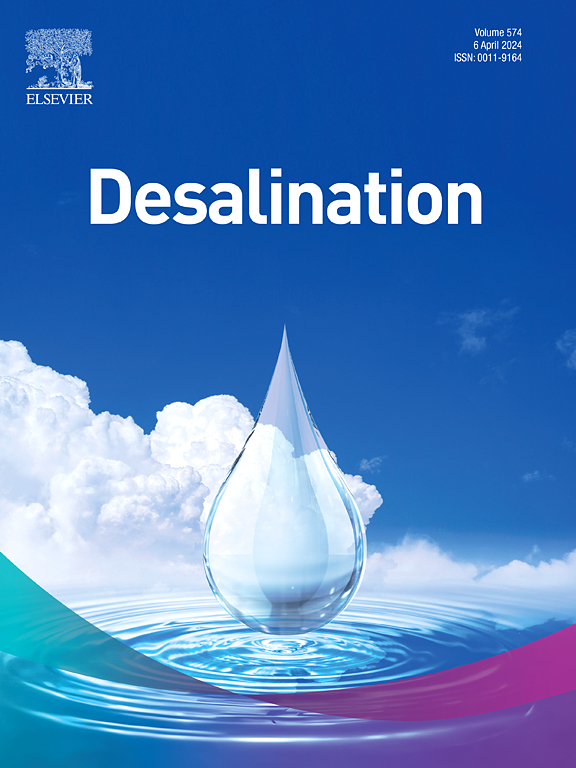Preparation of positively charged acid-resistant hollow fiber nanofiltration membrane with excellent separation performance by surface modification
IF 9.8
1区 工程技术
Q1 ENGINEERING, CHEMICAL
引用次数: 0
Abstract
There is a significant requirement for acid-resistant nanofiltration (NF) membranes with positively charged surface in order to effectively treat and recycle acidic industrial wastewater that contains heavy metal ions. Currently, acid-resistant nanofiltration membranes still exhibit low water permeance and typically display only weak positively charged or even negatively charged surface, which presents a vast challenge for the effective removal of heavy metal ions. In this work, we successfully produced a positively charged hollow fiber (HF) NF membrane with outstanding water permeability by combining interfacial polymerization and surface modification approaches. The interfacial polymerization reaction was conducted on the inner surface of an HF polysulfone substrate using polyethyleneimine as the aqueous monomer and cyanuric chloride as the organic monomer. This process results in the formation of a positively charged polyamine selective layer. Subsequently, the surface of the selective layer was modified with an aqueous solution of (3-bromopropyl) trimethylammonium bromide (BPTAB) via a Hoffman alkylation process, which increases the positive charge density and hydrophilicity of the HF NF membrane. Consequently, the BPTAB-modified HF NF membrane achieves a water permeance of 44.5 L m−2 h−1 MPa−1, which is a 130 % increase compared to the unmodified baseline HF NF membrane. Meanwhile, it exhibits excellent desalination performance, corresponding to a rejection of 97.3 %, 99.3 % and 99.1 %, for MgCl2, CoCl2 and MnCl2, respectively. Additionally, it demonstrates excellent resistance to acids, which remains a 93.3 % MgCl2 rejection after being submerged in pH = 1 HNO3 solution for 60 d.

采用表面改性法制备分离性能优良的带正电耐酸中空纤维纳滤膜
为了有效地处理和回收含重金属离子的酸性工业废水,对表面带正电的耐酸纳滤膜提出了很高的要求。目前,耐酸纳滤膜的水渗透性仍然很低,表面通常只有弱正电荷甚至负电荷,这对有效去除重金属离子提出了巨大的挑战。本文采用界面聚合和表面改性相结合的方法,成功制备了具有优异透水性的正电荷中空纤维(HF) NF膜。以聚亚胺为水单体,三聚氰胺为有机单体,在HF聚砜底物的内表面进行了界面聚合反应。这一过程导致形成带正电的多胺选择层。随后,用(3-溴丙基)三甲基溴化铵(BPTAB)水溶液进行Hoffman烷基化修饰,使HF - NF膜的正电荷密度和亲水性提高。因此,bptab修饰的HF - NF膜的透水性为44.5 L m−2 h−1 MPa−1,与未修饰的基线HF - NF膜相比,提高了130%。同时,对MgCl2、CoCl2和MnCl2的去除率分别为97.3%、99.3%和99.1%,具有优异的脱盐性能。此外,它还具有优异的耐酸性能,在pH = 1的HNO3溶液中浸泡60天后,MgCl2的去除率仍为93.3%。
本文章由计算机程序翻译,如有差异,请以英文原文为准。
求助全文
约1分钟内获得全文
求助全文
来源期刊

Desalination
工程技术-工程:化工
CiteScore
14.60
自引率
20.20%
发文量
619
审稿时长
41 days
期刊介绍:
Desalination is a scholarly journal that focuses on the field of desalination materials, processes, and associated technologies. It encompasses a wide range of disciplines and aims to publish exceptional papers in this area.
The journal invites submissions that explicitly revolve around water desalting and its applications to various sources such as seawater, groundwater, and wastewater. It particularly encourages research on diverse desalination methods including thermal, membrane, sorption, and hybrid processes.
By providing a platform for innovative studies, Desalination aims to advance the understanding and development of desalination technologies, promoting sustainable solutions for water scarcity challenges.
 求助内容:
求助内容: 应助结果提醒方式:
应助结果提醒方式:


